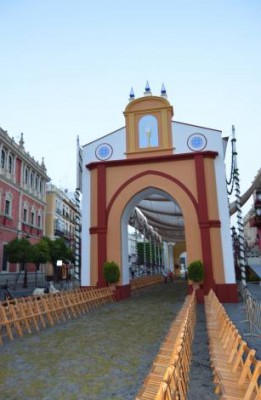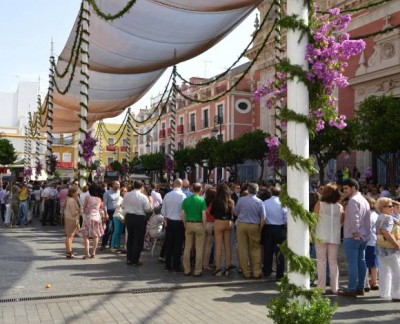SEVILLA, SPAIN. The Feast of Corpus Christi is a celebration of the tradition and belief that the body of blood of Jesus Christ is real and truly present in the Eucharist. While Catholic churches in Spain recognize and celebrate Corpus Christi, Sevilla’s celebrations out due most. The main events lie in the heart of one of the town’s main attraction, the San Isidoro Cathedral, and pour out into the city.
Surrounded by swarms of people, bells ringing, banners floating in the wind, and an overwhelming procession, this wasn’t exactly how I had pictured what my trip Sevilla would look like. Sevilla in itself is an intricate town with its history juxtaposed to its modernization.
Witnessing this religious holiday only added to the rich history of Sevilla. The whole town seemed to be taken over by the celebration. The main streets were covered in rose petals, rosemary and different foliage all leading to the Cathedral. These streets were decorated for a processional before and after mass, made up of locals of all ages carrying candles, a group of military men and women marching, and drummers. There were numerous different adoration altars along the procession and the “Custodia”—a hand carved religious “house” for the Holy Eucharist by Juan de Arfe in the 1900s.

One of the many walkways built down the main road to the Cathedral
With every step, I noticed something different and new, but for me, being a tourist made the festivities hard to take in all at once.
Sheridan Schuessler, a student from the United States studying in Madrid for the summer, felt the same sense of overwhelm but knew she was a part of something very important to the culture of Sevilla.
“After following the rows of chairs and rosemary to the Cathedral, it was a bit overwhelming to see all of the people,” Schuessler said. “I tried to enter the Cathedral with everyone else but was clearly spotted as a tourist and told to go to another entrance, where they kindly let me in for the Corpus Christi mass service. It was amazing. I’m not very religious but I understand why it was so important to all of the people who came to celebrate.”

Atendees of the Corpus Christi celebration gather to watch the procession into the Cathedral
Lauren Snyder, another student, witnessed this same sense of adoration during the celebrations, but felt a kinship to other tourists and those that seemed less a part of the events.
“What interested me the most was observing the people and the different generations in attendance,” Snyder said. “It was so interesting to see the different ways that both young and old celebrated the holiday. Some were more formal than others, and some seemed more pensive and serious while others were simply along for the ride with their families.”
Even though I, along with other tourists, may have felt like an outsider to an event we were strangers to, getting to participate in something that meant so much to the locals of Sevilla was an experience in itself. The parade and the festivities may have blocked off some of the main streets of Sevilla, causing us to take a few detours to other attractions of the town, but the anxiety and extra time was more than worth the experience. Like some locals, I was just along for the ride.

